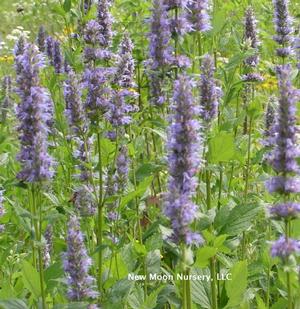New Moon Nurseries
Agastache foeniculum
Anise Hyssop
Native to North America
FIRST IMPRESSIONS: Agastache foeniculum is an upright perennial with light green angular stems. Plants are clothed in lovely anise scented leaves. In summer, lavender to purple flower spikes draw a crowd of bees, butterflies and other pollinators. Plants thrive in sunny well drained sites.
HABITAT & HARDINESS: Agastache foeniculum is native to most of the southern Canadian provinces and the Northwest Territory. The species occurs in Connecticut, New York, New Hampshire, New Jersey, Pennsylvania, Kentucky and from Michigan to Montana south to Illinois, Colorado and Wyoming.
Typical habitats included upland sections of prairies, shrubby barrens, dry upland woods and thickets.
Plants are hardy in USDA Zones 4-8.
PLANT DESCRIPTION: This mounding warm season perennial bears attractive pubescent licorice scented leaves.
Blades are heart shaped or broadly lanceolate with rounded teeth. They are opposite with short petioles and are reminiscent of catnip or catmint. The surface is a soft gray-green and undersides are covered in pale silvery hairs.
Loads of spikey lavender to blue-violet flowers emerge in summer. The spikes are 3-6” long and are densely packed with small tubular florets.
The florets have purplish calyxes which extends the season of color. Blooming continues for about two months before the florets are replaced by smooth oval nutlets.
Plants are 2-4’ tall with a 2-3’ spread.
CULTURAL & MAINTENANCE NEEDS: Agastache foeniculum favors a sunny site with well drained sandy loam soil. Plants will tolerate drought, light shade, clay-loam or gravelly soils and acid or alkaline pH.
The most important cultural need for this plant is good drainage. Heavy layers of mulch can hold too much water so plants should be mulched lightly or not at all. If drainage is not good, plants are likely to succumb to winter injury.
Flowering will continue for longer periods if plants are dead-headed.
Plants are pest resistant and the aromatic foliage makes shoots unpalatable to deer and rabbits.
LANDSCAPE USES: Agastache foeniculum is a wonderful Accent when covered with bottlebrush blossoms and a cloud of butterflies. It is at home in Herb Gardens or Perennial Borders and is used as a Butterfly Nectar Plant or as part of a Grouping or Mass Planting. Plants provide Fragrance, Showy Blooms, Cut Flowers and are valuable components of Cottage Gardens, Water-wise Landscapes, Low Maintenance Plantings and Wildlife Gardens.
COMPANION & UNDERSTUDY PLANTS: Agastache foeniculum mingles nicely with Callirhoe involucrata, Echinacea purpurea, Rudbeckia fulgida var. fulgida or Solidago nemoralis. Blue tinged grasses like Panicum virgatum 'Prairie Sky' and Schizachyrium scoparium ‘The Blues’ provide a nice contrast.
If a substitute is needed, Agastache foeniculum 'Blue Fortune' or Scuttelaria incana could be a good choice.
TRIVIA: Like most aromatic herbs this plant is a member of the Mint Family (Lamiaceae). The genus name Agastache is Greek for “many spikes”. The specific epithet is from a Latin word that means “hay”.
Flowers are pollinated primarily by various types of bees including honeybees, bumblebees, Halictid bees, digger bees, leaf-cutting bees and masked bees. Flowers are also visited by pollinating flies, butterflies, skippers, moths and the occasional hummingbird. Due to the aromatic foliage, plants are not palatable to deer and other herbivores.
The aromatic leaves can be harvested and used to make herbal teas or jellies.
Height:
2-4 ftSpread:
2-3 ftUSDA Hardiness Zone:
4-8Bloom Color:
LavenderAgastache foeniculum Characteristics
Attracts Wildlife
- Butterflies
- Pollinators
- Hummingbirds
Attributes
- Fragrant
- East-Coast Native
- Drought Tolerant
- Dried Flower
- Naturalizing
- Interesting Foliage
Exposure
- Full Sun to Partial Shade
Deer Resistant
- Deer Resistant
Flowering Months
- September
- August
- July
Foliage Color
- Green
Growth Rate
- Medium
Salt Tolerance
- Medium
Season of Interest (Foliage)
- Summer
- Spring
Soil Moisture Preference
- Dry to Moist
